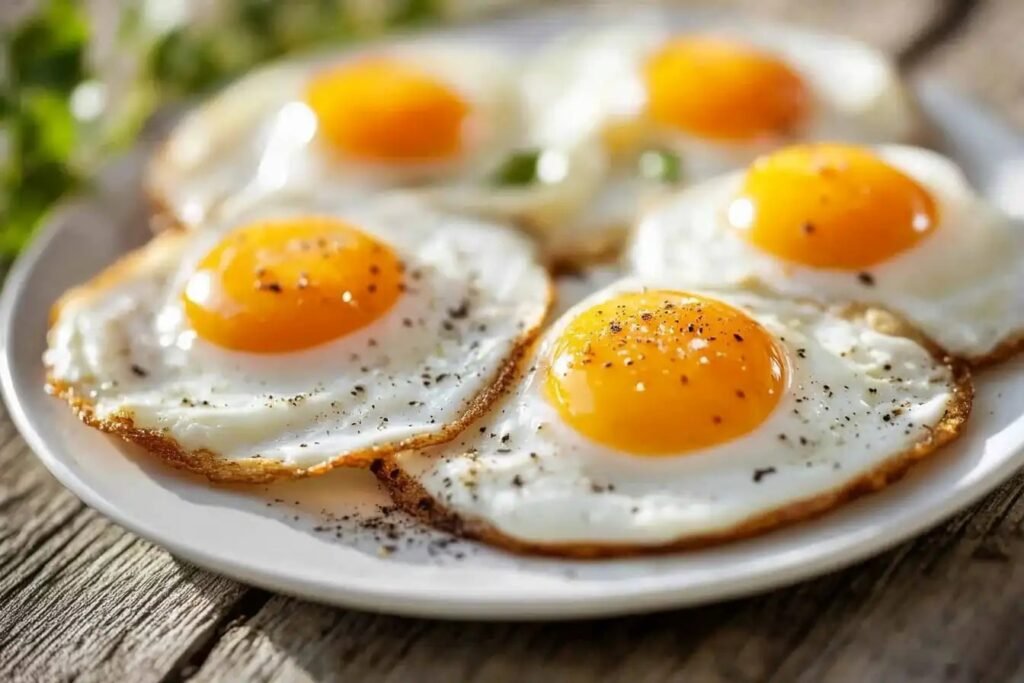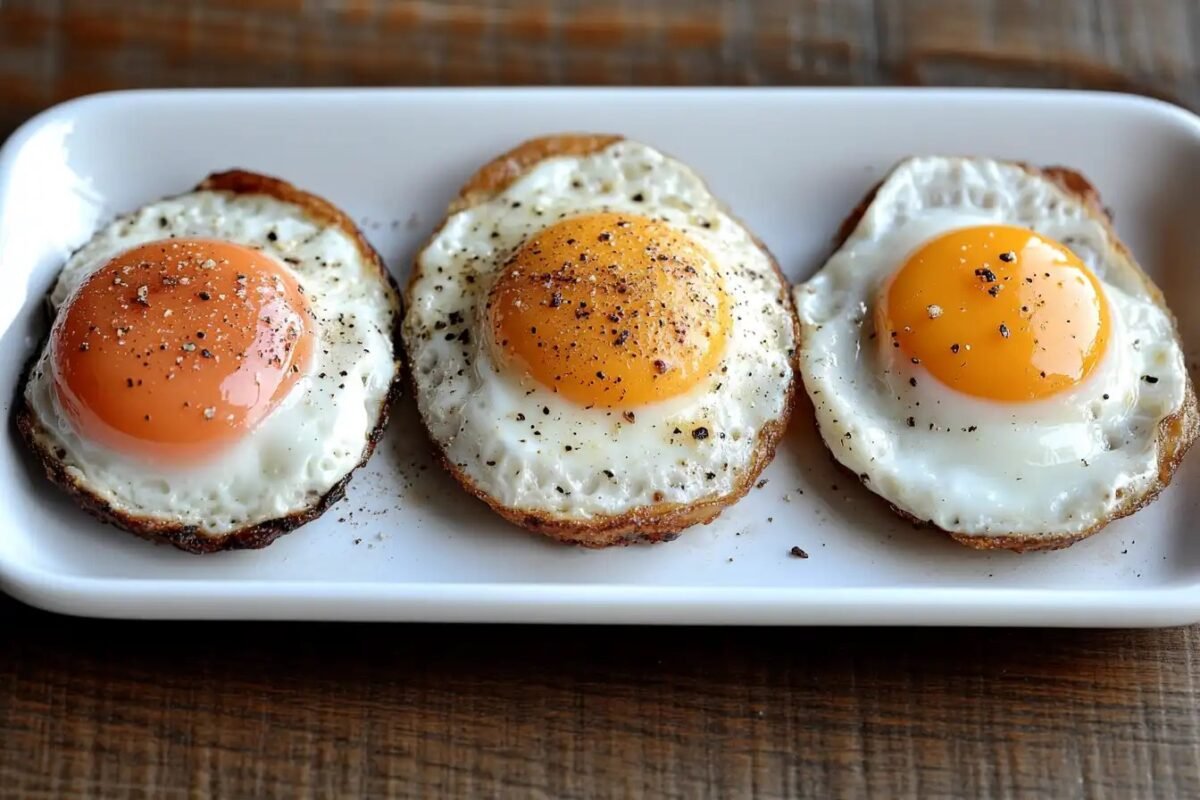Fried eggs are a breakfast staple that can be prepared in several styles, each with its unique texture and flavor. Whether you love a runny yolk for dipping toast or prefer a fully cooked yolk for a hearty meal, knowing the different types of fried eggs is a skill every home cook should master. So, what are the 4 types of fried eggs? This article explores each style in detail, from sunny side up to over hard, with tips on cooking them perfectly and pairing them with meals. Let’s dive in!
Introduction to Fried Eggs
Why Fried Eggs Are a Breakfast Staple
Fried eggs have been a culinary favorite for centuries. Their simplicity, versatility, and quick preparation make them a go-to option for busy mornings or leisurely brunches. You can pair them with toast, hash browns, salads, or even rice dishes for a satisfying meal.
What makes fried eggs so appealing is how they cater to different tastes. Some prefer the silky yolk of a sunny-side-up egg, while others enjoy the firm texture of an over-hard egg. No matter your preference, fried eggs can be the perfect addition to any dish.
Overview of the Four Types of Fried Eggs
So, what are the 4 types of fried eggs? The four main types are:
- Sunny Side Up: Cooked on one side with a runny yolk.
- Over Easy: Flipped briefly, with a soft and runny yolk.
- Over Medium: Flipped and cooked until the yolk is partially set.
- Over Hard: Fully flipped and cooked until the yolk is firm.
Each style offers a unique eating experience, making it fun to experiment and find your favorite. The following sections will provide step-by-step instructions and tips for mastering each type.
Sunny Side Up: The Basics
What Does Sunny Side Up Mean?
Sunny side up is the quintessential fried egg, known for its bright, sunny yolk. This style is cooked on one side only, leaving the yolk soft and runny. The whites are cooked just enough to set, with no flipping involved. For those who enjoy dipping bread into a silky yolk, this is the perfect option.
This classic style is ideal for breakfast plates and works beautifully as a topping for avocado toast or a burger. Its simplicity highlights the egg’s natural flavor, making it a favorite worldwide.
How to Cook a Perfect Sunny Side Up Egg

- Heat a non-stick skillet over medium heat and add a small amount of butter or oil.
- Crack the egg into a small bowl to ensure no shells make it into the pan.
- Gently slide the egg into the pan.
- Cook the egg for about 2–3 minutes, or until the whites are fully set but the yolk remains runny.
- Season with salt and pepper before serving.
Common Uses for Sunny Side Up Eggs
Sunny side up eggs are a versatile addition to many meals. Pair them with classic breakfast staples like hash browns and toast, or add them to rice dishes, noodle bowls, or even pizzas. The vibrant yolk adds a pop of color and flavor to any dish.
For more tips on egg preparation, visit Quinto Recipes’ step-by-step guide.
Over Easy Eggs Explained
Characteristics of Over Easy Eggs
Over easy eggs take the sunny side up style a step further. These eggs are flipped briefly during cooking, creating a thin, lightly cooked layer over the yolk while keeping the center soft and runny. The result is a delicate balance between firm whites and a creamy yolk.
This style is perfect for those who enjoy runny yolks but prefer a slightly more cooked texture on top. Over easy eggs work well as a topping for toast or served alongside crispy bacon and sautéed vegetables.
How to Cook Over Easy Eggs Step by Step
- Preheat your skillet over medium heat and add butter or oil.
- Crack the egg into a bowl and gently pour it into the pan.
- Cook until the whites are set, about 2 minutes.
- Using a flat spatula, carefully flip the egg over. Cook for an additional 10–20 seconds.
- Serve immediately, seasoning with salt and pepper to taste.
Pairing Over Easy Eggs with Meals
Over easy eggs are a versatile choice for breakfast and beyond. Add them to breakfast burritos, grain bowls, or even burgers for a creamy yolk that enhances every bite.
For more ideas and egg-related inspiration, explore Quinto Recipes’ egg fry recipes.
Over Medium Eggs: The Middle Ground
What Sets Over Medium Eggs Apart?
Over medium eggs are a balance between runny and firm yolks, making them a popular choice for those who enjoy a slightly creamy but not overly runny center. These eggs are flipped during cooking, like over easy eggs, but are left in the pan longer to let the yolk cook to a semi-solid consistency.
If you’ve ever wondered what are the 4 types of fried eggs, over medium eggs are often considered the “just right” option. They strike a perfect compromise for diners who want their eggs cooked but not dry.
Cooking Over Medium Eggs Like a Pro
- Heat a non-stick skillet on medium heat and add a small amount of butter or oil.
- Crack the egg into a small bowl to avoid shells, then slide it into the pan.
- Let the whites cook until fully set, about 2–3 minutes.
- Carefully flip the egg with a spatula. Cook for another 30–60 seconds, checking for a slightly firm but creamy yolk.
- Remove from the pan and season with salt and pepper before serving.
Best Dishes to Serve with Over Medium Eggs
Over medium eggs are a versatile addition to various meals. They’re an excellent topping for breakfast sandwiches, grain bowls, and salads. The semi-set yolk adds a creamy texture without overwhelming other ingredients, making it ideal for layered dishes.
For more inspiration on cooking egg varieties, visit Quinto Recipes’ guide to egg-based dishes.
Over Hard Eggs: Fully Cooked and Delicious
Understanding Over Hard Eggs
Over hard eggs are the final entry when answering what are the 4 types of fried eggs. These eggs are flipped and cooked until the yolk is fully set, offering a firm, solid texture. They’re the perfect choice for those who prefer their eggs well-done, with no runniness at all.
This style works beautifully in sandwiches or alongside breakfast classics like bacon and hash browns. The fully cooked yolk makes over hard eggs ideal for people who enjoy a hearty, satisfying bite.
Tips for Cooking Perfect Over Hard Eggs
- Preheat your skillet over medium heat and add a touch of butter or oil.
- Crack the egg into the pan directly or use a small bowl for precision.
- Let the whites cook until fully set, about 2–3 minutes.
- Flip the egg and cook for an additional 1–2 minutes until the yolk is firm.
- Season as desired and serve immediately.
Pairing Over Hard Eggs with Other Foods
Over hard eggs are incredibly versatile. Add them to breakfast wraps, club sandwiches, or serve them with sautéed vegetables for a balanced meal. Their firm texture holds up well in dishes that require sturdier eggs.
If you’re eager to explore more recipes that incorporate fried eggs, check out Quinto Recipes’ egg fry recipes.
Choosing the Right Fried Egg for You
Differences Between the 4 Types of Fried Eggs
When it comes to deciding what are the 4 types of fried eggs and which one is best for you, it’s all about personal preference. Each style offers a unique texture and flavor profile:
- Sunny Side Up: Ideal for those who enjoy a runny yolk and soft whites.
- Over Easy: Perfect for dipping or spreading, with slightly more cooked whites.
- Over Medium: Offers a creamy yolk with a firmer texture.
- Over Hard: Best for those who prefer a fully cooked yolk and sturdy whites.
Understanding these differences can help you choose the perfect style for your taste or dish. For instance, sunny side up eggs are great for breakfast plates, while over hard eggs are perfect for sandwiches or meal prep.
Factors to Consider: Texture, Flavor, and Use
When selecting your fried egg style, think about texture and how it complements your meal. Runny yolks add richness to dishes like avocado toast or rice bowls, while firmer yolks work well in wraps or alongside sautéed vegetables.
Flavor is another factor. Butter enhances richness, while oil gives a lighter, crispier finish. Experiment with different fats and cooking times to find your favorite combination.
For more guidance on pairing eggs with meals, explore Quinto Recipes’ guide to egg frying techniques.
FAQs About the Types of Fried Eggs
What Are the 4 Levels of Fried Eggs?
The four levels of fried eggs—sunny side up, over easy, over medium, and over hard—reflect varying degrees of doneness. From runny yolks to fully cooked, each level offers a distinct texture and flavor.
What’s the Difference Between Over Well and Over Hard?
Over hard and over well eggs are very similar, but over well eggs are typically cooked for longer, ensuring both the yolk and whites are completely firm and browned if desired.
Are Over Easy and Fried Eggs the Same?
Over easy eggs are a type of fried egg. They are flipped briefly during cooking, resulting in a soft, runny yolk. Not all fried eggs are flipped, making sunny side up a different category.
How Do I Choose the Best Fried Egg Style?
Consider how you plan to use the egg and your preference for yolk texture. For dipping, choose sunny side up or over easy. For sandwiches or meal prep, over medium or over hard eggs work best.
Health and Nutritional Considerations of Fried Eggs
Nutritional Benefits of Fried Eggs
Fried eggs are a great source of high-quality protein, essential vitamins, and minerals. Each egg provides about 6 grams of protein, along with important nutrients like vitamin D, B12, and selenium. If you’re asking what are the 4 types of fried eggs and their health benefits, the cooking method can slightly impact the nutritional profile. For instance:
- Sunny side up and over easy eggs preserve the yolk’s nutrients due to minimal cooking.
- Over medium and over hard eggs may lose some nutrients from prolonged heat but are still nutrient-dense.
The type of fat used for frying also plays a role. Using olive oil or avocado oil can add healthy monounsaturated fats, while butter contributes a richer flavor and some vitamins like A and D.
Healthier Cooking Tips
To make fried eggs healthier, try these tips:
- Use a non-stick pan to reduce the need for excessive oil or butter.
- Opt for heart-friendly oils like olive or avocado oil.
- Pair fried eggs with nutrient-dense sides like whole-grain toast, sautéed spinach, or fresh avocado.
No matter which style of fried egg you prefer, keeping these tips in mind can help you enjoy your favorite dish while maintaining a balanced diet.
Conclusion and Final Thoughts
Recap of the 4 Types of Fried Eggs
So, what are the 4 types of fried eggs? Sunny side up, over easy, over medium, and over hard eggs each offer something unique. Whether you love the runny yolk of sunny side up eggs or the firm texture of over hard eggs, there’s a style for everyone.
Encouragement to Experiment
Cooking eggs is about finding the style that suits your taste and your dish. Experiment with different fats, cooking times, and pairings to discover your favorite. Sunny side up eggs shine on breakfast plates, while over medium and over hard eggs work wonderfully in sandwiches or as meal prep staples.
If you’re curious to learn more or try creative recipes featuring fried eggs, check out Quinto Recipes’ egg fry ideas. Whether you’re making breakfast, lunch, or dinner, fried eggs are a versatile and satisfying addition to any meal.
